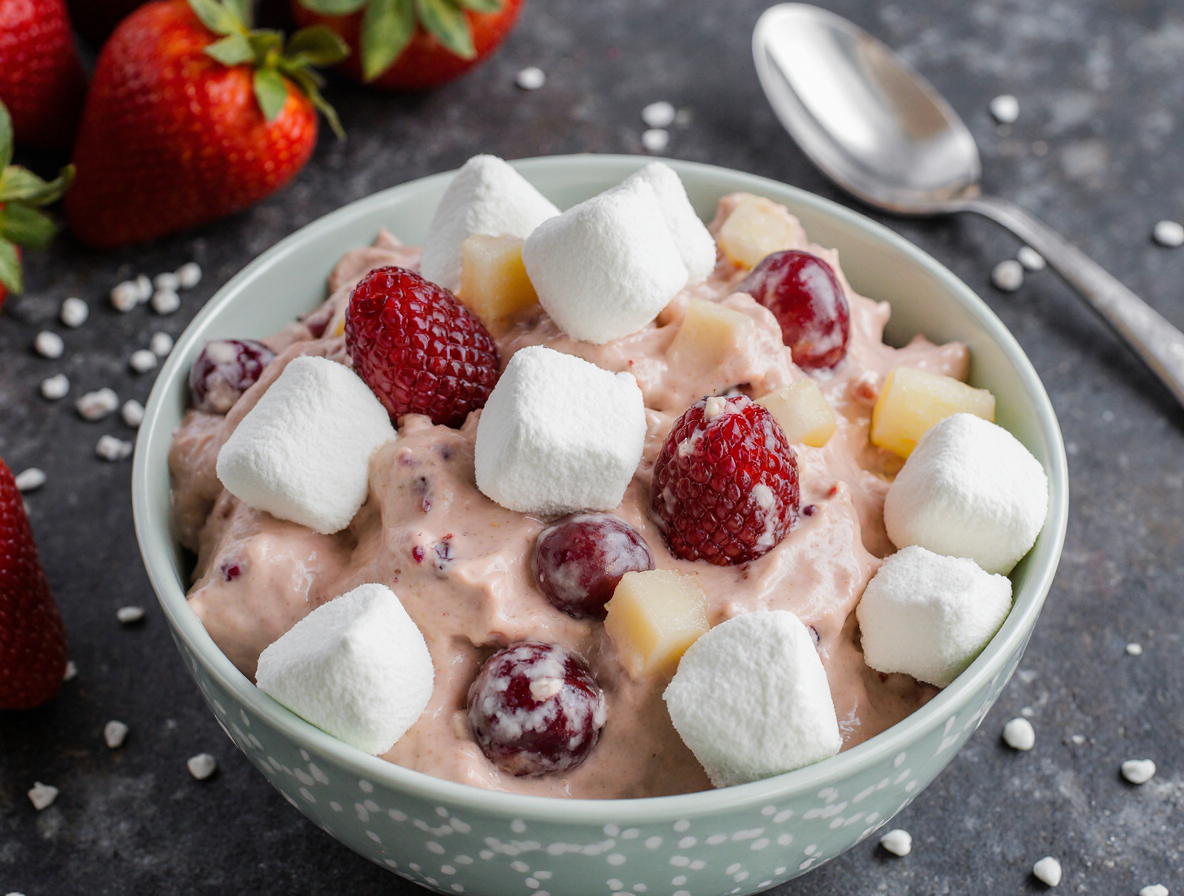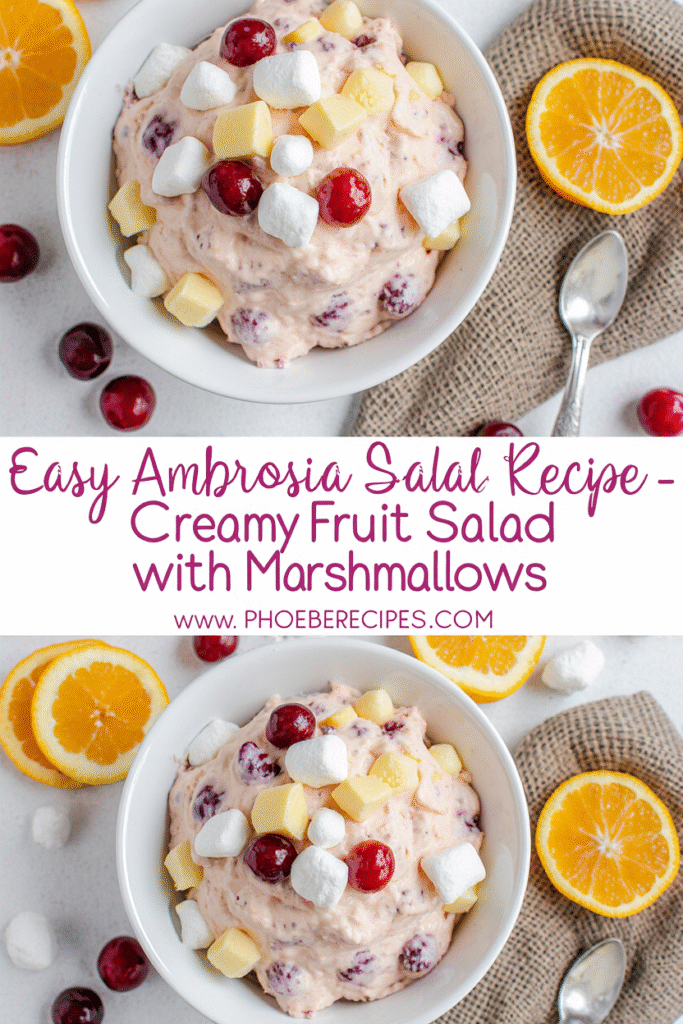Perfect Ambrosia Salad Recipe: Grandma’s Secret Method Revealed
Ambrosia salad recipe has been a treasured part of my family for years and years. This classic American dessert, whose name actually means “food of the gods,” has stood the test of time with its irresistible combination of sweet fruits, creamy texture, and fluffy marshmallows.
The traditional ambrosia recipe typically includes a delightful mix of mandarin oranges, pineapple, and maraschino cherries, all brought together with a creamy base that can include sour cream, whipped topping, yogurt, or even mayonnaise. What makes this classic ambrosia salad recipe so beloved is its versatility and universal appeal—it’s just plain good. With 393 calories per serving, this easy ambrosia salad recipe is perfect for every occasion, especially summer months and hot days, though it also shines as a festive addition to holiday gatherings. In this article, I’ll reveal my grandmother’s secret method for creating the best ambrosia salad recipe that’s guaranteed to impress at your next potluck since it’s best made ahead of time.
The Classic Ambrosia Salad Base
Every classic ambrosia salad recipe begins with a foundation of exceptional ingredients that work harmoniously together. Let me walk you through what makes this timeless dessert truly special.
Traditional fruits used in ambrosia salad
The heart of any authentic ambrosia fruit salad recipe lies in its fruit selection. Traditional ambrosia almost always contains these essential fruits:
- Mandarin oranges (typically canned and well-drained)
- Pineapple (tidbits, chunks, or crushed – all work beautifully)
- Maraschino cherries for that pop of color and sweet flavor
While these three fruits form the classic base, many family recipes incorporate additional fruits. My grandmother often added canned fruit cocktail and fresh grapes for extra dimension. Furthermore, some variations include chopped apples, pears, bananas, strawberries, or even kiwi for a tropical twist.
One critical step when preparing your fruits: drain them thoroughly! Excess moisture can quickly turn your beautiful ambrosia into a soupy mess. I occasionally blot the fruits with paper towels to remove any lingering moisture.
Why sour cream and Cool Whip work so well together
The magic of a traditional ambrosia recipe happens when sour cream and whipped topping (commonly Cool Whip) combine. This duo creates the perfect balance between sweet and tangy. The sour cream adds a pleasant tanginess that offsets the sweetness from the fruits and marshmallows, while the whipped topping contributes airy lightness.
Many nutritionists note that a typical serving of ambrosia salad contains approximately 156 calories, with 20g of carbohydrates and 9g of fat. Nevertheless, you can modify the recipe based on dietary preferences—some families use Greek yogurt instead of sour cream for a lighter option with similar tanginess.
The role of mini marshmallows and coconut
Mini marshmallows aren’t merely a decorative addition—they’re fundamental to the classic ambrosia salad recipe’s texture and taste. As the salad rests, the marshmallows gradually soften, creating that distinctive melt-in-your-mouth experience that defines authentic ambrosia.
Coconut, typically sweetened and shredded, provides both texture and flavor complexity. It adds a delightful chewiness that contrasts beautifully with the creamy base and soft fruits. Notably, some creative cooks toast the coconut beforehand for a richer flavor profile.
The interaction between all these elements—juicy fruits, creamy base, fluffy marshmallows, and chewy coconut—creates that distinctive ambrosia experience that has made this recipe a beloved staple at family gatherings for generations.
Grandma’s Secret Method Revealed
Now that we’ve covered the basics, let me share what truly makes my grandmother’s ambrosia salad recipe exceptional. Her method elevates this classic dessert from good to absolutely unforgettable.
The importance of draining fruit properly
Grandma always insisted that properly drained fruit was the cornerstone of perfect ambrosia. She would drain canned fruits in a colander for at least 30 minutes, then pat them dry with paper towels. “Excess moisture is the enemy of good ambrosia,” she’d say with conviction. This extra step prevents that dreaded soupy consistency that ruins texture and dilutes flavor in your traditional ambrosia recipe.
Letting the salad rest overnight
According to Grandma, patience creates perfection. After mixing all ingredients, she would cover the bowl tightly and refrigerate it for at least 8 hours—preferably overnight. During this resting period, magic happens: flavors meld beautifully, marshmallows soften just right, and the creamy mixture sets to ideal consistency. This waiting period transforms a good ambrosia fruit salad recipe into the best ambrosia salad recipe you’ve ever tasted.
Using pastel marshmallows for flavor and color
Unlike many recipes that call for plain white mini marshmallows, Grandma insisted on using pastel-colored varieties. Beyond adding visual appeal, she maintained that the subtle flavor variations in colored marshmallows contributed complexity to the classic ambrosia salad recipe. The pink ones particularly complement the cherries, creating flavor harmony throughout the dish.
Folding technique to avoid breaking fruit
Grandma’s mixing technique was gentle yet effective. She used a large rubber spatula to fold ingredients rather than stir them. Starting with the creamy base, she would add fruits gradually, folding from bottom to top with a turning motion. This careful technique preserves fruit integrity—particularly important for delicate mandarin oranges. The result? An easy ambrosia salad recipe where every bite contains perfectly intact fruit pieces surrounded by creamy goodness.
Customizing Your Ambrosia Salad
One of the joys of making ambrosia salad is its incredible adaptability. The classic ambrosia salad recipe serves as a canvas for creative variations that can suit any preference or dietary need.
Fresh vs canned fruit options
Though traditional ambrosia salad recipes often call for canned fruits, fresh alternatives can elevate your creation significantly. Fresh pineapple chunks offer brighter flavor than their canned counterparts, albeit with slightly less sweetness. For a perfectly balanced ambrosia fruit salad recipe, consider combining both—perhaps using canned mandarin oranges for convenience alongside fresh strawberries or blueberries. Interestingly, many home cooks find that keeping crushed pineapple (even if canned) provides essential moisture to the mixture.
Adding nuts for crunch
Beyond doubt, nuts contribute delightful textural contrast to an otherwise soft dessert. Toasted pecans remain the classic choice, yet walnuts provide equally satisfying results. For something unexpected, try slivered almonds. Regardless of your selection, toasting nuts beforehand intensifies their flavor profile dramatically. As a general guideline, about 1/2 cup of chopped nuts per standard recipe creates ideal balance.
Using Greek yogurt or cream cheese instead of sour cream
Greek yogurt serves as an excellent substitute for sour cream in any easy ambrosia salad recipe, delivering similar tanginess with added protein benefits. Moreover, cream cheese creates an indulgently rich base—simply combine 8 ounces with heavy cream for luxurious texture. Some enthusiasts even blend 4 ounces of whipped cream with 1/8 cup sour cream for a compromise between traditions.
Tropical and berry variations
For tropical-inspired versions:
- Add mango, papaya, or dragon fruit for authentic Hawaiian flavor
- Include lychee or passion fruit for exotic sweetness
- Incorporate kiwi for bright color and tangy taste
Berry variations have gained popularity recently, with mixed berry ambrosia featuring strawberries, blueberries, blackberries, and raspberries in place of traditional fruits.
Tips for making it dairy-free
Making dairy-free ambrosia is surprisingly simple. Coconut cream substitutes beautifully for whipped cream, whereas plant-based yogurt alternatives work effectively in place of Greek yogurt or sour cream. Essentially, any high-quality dairy-free yogurt with almond or soy base creates satisfying results. Remember that vegan marshmallows will be necessary for completely plant-based versions.
Serving, Storing, and Making Ahead
The versatility of a good ambrosia salad recipe extends beyond just ingredients—it’s also about how you serve, store, and prepare it ahead of time. This classic treat offers remarkable flexibility for your entertaining needs.
Is it a dessert or a side dish?
The classification of ambrosia salad remains an ongoing friendly debate among food enthusiasts. Traditionally, it’s considered a dish with layers of citrus, sugar, and coconut that became popular in the South during holiday seasons. In many households, ambrosia salad walks the line between both worlds—served as a sweet side dish alongside holiday meals but equally at home on the dessert table. The preparation method typically determines its classification: versions made with marshmallow fluff lean toward dessert territory, while those using sour cream or mayonnaise fit more comfortably in the salad category.
How long to chill before serving
For optimal flavor development, ambrosia salad needs time to chill properly. Most recipes recommend refrigerating for at least 4 hours before serving, though overnight resting produces the best results. This “marrying” period allows the marshmallows to soften and the flavors to blend harmoniously. For those in a time crunch, a minimum 30-minute chill will suffice, but the flavor profile certainly improves with patience.
How to store leftovers properly
Leftover ambrosia salad should always be kept in an airtight container in the refrigerator. Under proper refrigeration, it typically remains delicious for 3-5 days. Beyond this timeframe, the quality begins to decline as the marshmallows become overly soft and the fruits release more liquid. Although freezing is technically possible, I don’t recommend it as the texture significantly changes upon thawing—the fruits won’t hold up well.
Why it’s perfect for holidays and potlucks
First of all, ambrosia salad shines at gatherings because it’s genuinely better when made ahead—a rare quality that reduces day-of preparation stress. Its colorful appearance makes it a festive addition to holiday tables, particularly for spring celebrations like Easter and Mother’s Day where the pastel colors feel especially appropriate. Additionally, the recipe scales easily for crowds and travels well. In fact, this classic dish has become a staple at everything from family holiday dinners to potlucks, picnics, and barbecues.
Conclusion
Ambrosia salad truly stands as a timeless classic that connects generations through its sweet, creamy goodness. Throughout this article, we’ve explored what makes this beloved dish so special, from its traditional fruit combinations to my grandmother’s closely guarded techniques. Her insistence on properly draining fruits, using pastel marshmallows, and allowing the salad to rest overnight certainly transforms an ordinary recipe into something extraordinary.
What makes ambrosia salad particularly wonderful is its adaptability. You can easily adjust it to suit your taste preferences or dietary needs while still maintaining its characteristic charm. Fresh fruits can replace canned ones, nuts can add delightful crunch, and dairy-free alternatives work surprisingly well for those with restrictions.
Perhaps most importantly, ambrosia salad brings people together. This versatile dish works equally well as a side or dessert, brightening holiday tables and casual gatherings alike. The fact that it improves when made ahead of time makes it perfect for busy hosts who want to spend time with guests rather than in the kitchen.
My grandmother would always say that food carries memories, and accordingly, this recipe carries hers forward. Though simple in concept, ambrosia salad connects us to traditions while allowing for personal expression. Therefore, I encourage you to try this recipe, making it your own while honoring its classic roots. After all, the best dishes aren’t just about following instructions but about sharing joy through food made with care and love.
FAQs
Q1. What are the essential ingredients for a classic ambrosia salad? A classic ambrosia salad typically includes mandarin oranges, pineapple, maraschino cherries, mini marshmallows, coconut, and a creamy base made from sour cream and whipped topping.
Q2. How long should ambrosia salad chill before serving? For the best flavor, chill ambrosia salad for at least 4 hours before serving. However, letting it rest overnight in the refrigerator produces optimal results, allowing flavors to meld and marshmallows to soften perfectly.
Q3. Can I make ambrosia salad dairy-free? Yes, you can make dairy-free ambrosia salad by substituting coconut cream for whipped cream and using plant-based yogurt alternatives in place of sour cream or Greek yogurt. Be sure to use vegan marshmallows for a completely plant-based version.
Q4. How long can I store leftover ambrosia salad? Leftover ambrosia salad can be stored in an airtight container in the refrigerator for 3-5 days. Beyond this time, the quality may decline as the marshmallows become too soft and the fruits release more liquid.
Q5. What makes ambrosia salad perfect for potlucks and holidays? Ambrosia salad is ideal for potlucks and holidays because it’s better when made ahead, reducing day-of preparation stress. It’s also visually appealing, easy to transport, scales well for large gatherings, and its festive appearance makes it suitable for various celebrations.


